SpeakerDave: yes, thanks, some credibility. Experience helps, experience and a fairly unlimited budget helps even more.
So the question becomes about the tweeter(s) again: what kind of harm does having a smaller tweeter array inside the woofer array create? Also, what does making an "expanded D'Appolito" array make (putting the tweeter in the center of the stack)? My plan would probably be for full floor-to-ceiling.
So what happens if I do have digital filtering? Are they usable or are they still too awful? It seems like a screechy/peaky 94 db sensitive tweeter will turn into an 89 db or less after eq-ing, no?
So the question becomes about the tweeter(s) again: what kind of harm does having a smaller tweeter array inside the woofer array create? Also, what does making an "expanded D'Appolito" array make (putting the tweeter in the center of the stack)? My plan would probably be for full floor-to-ceiling.
*After messing around with peizos my conclusion was that they are completly not workable as tweeters due to very uneven frequancy response that would require digital filtering to correct.
So what happens if I do have digital filtering? Are they usable or are they still too awful? It seems like a screechy/peaky 94 db sensitive tweeter will turn into an 89 db or less after eq-ing, no?
What I mean is, short collumn of tweeters on the side of the woofers (centered around ear level).what kind of harm does having a smaller tweeter array inside the woofer array create?
...WWWWWTWWWWW... configuration where the tweeter is in line with the woofers. This seems like it would have some problematic vertical dispersion, but I don't know if experience proves otherwise.Also, what does making an "expanded D'Appolito" array make (putting the tweeter in the center of the stack)?
BTW, I'm fully aware of what comb filtering sounds like; I had installed those cheap Technics round "ribbon" tweeters in some old Onkyo towers. They overall were a big improvement in imaging, flatness, FR, etc, but created some NASTY comb filtering effects that could be heart easily by plugging one ear, turning the other towards the speaker, and moving side to side (relative to the speaker) even only an inch or two. Dispersion was horrible. I did wonder if a line of those would create a more even field since they may fill each other's voids.
As far as your stack of full-ranges go, how does the EQ curve look?
I'll be frank, the center driver (there are 11) is cut off below 4.5khz using a single capacitor, and the rest of the array isn't 100% symmetrically wired either. The rest of the drivers are wired to present an overall impedance of something close to 8 ohms, using inequal length impedance lines. It's a little messy in impedance terms but it works because there's no speaker-level crossover and the amp is able to handle it fine.
The EQ requires a 3dB shelf at about 6Khz (above which the 3" drivers have very little response and without the complex wiring, would require a much higher shelf), a cut at the -6dB notch frequency of the open baffle - though you'll notice the baffle is shaped to spread that frequency around a bit and make it easier to EQ, and a bit of tweaking to make the bass merge properly. My biggest issue is the very bad phase shift at the main crossover frequency of 330Hz given the orientation difference between the side-firing woofer and the upper bit of the speaker, obviously EQ is not the answer here but the speakers are 1000 miles away from where I live now so it can wait.
SpeakerDave: yes, thanks, some credibility. Experience helps, experience and a fairly unlimited budget helps even more.
So the question becomes about the tweeter(s) again: what kind of harm does having a smaller tweeter array inside the woofer array create?
If you mean a row of tweeters and a row of woofers side by side, that should give no particular problem. Each array has its own vertical directivity based on length, spacing and frequency. In addition you'll have a bit of lobing in the lateral plane when you cross over from woofer array to tweeter array. In the end it is no different than having a single woofer and a singel tweeter side by side. Best you can do is keep the two rows tight and try to crossover low. Lots of commercial systems have been configured that way.
Also, what does making an "expanded D'Appolito" array make (putting the tweeter in the center of the stack)? My plan would probably be for full floor-to-ceiling.
I find these more interesting and created a number of system under the XA (eXpanding Array) name at Snell. Done right you can get very constant vertical directivity, wider vertical dispersion than a line array (probably a good thing) and very even frequency response.
Patrick Bateman discussed one of them here:
http://www.diyaudio.com/forums/multi-way/159706-dappolito-arrays-waveguides.html
Regards,
David
I couldn’t decide if I should post this earlier in the thread but it’s Friday so what the heck. While this fits your title requirements, I am not sure it is what you want to build.
On the other hand, there is something nearly hypnotic (or possibly narcotic) about this video.
Put headphones on and enjoy this multi-part line array “how to video”.
Linear Array - Line Array - Fake Bose L1 PAS Part 1 of 6 - YouTube
On the other hand, there is something nearly hypnotic (or possibly narcotic) about this video.
Put headphones on and enjoy this multi-part line array “how to video”.
Linear Array - Line Array - Fake Bose L1 PAS Part 1 of 6 - YouTube
I couldn’t decide if I should post this earlier in the thread but it’s Friday so what the heck. While this fits your title requirements, I am not sure it is what you want to build.
On the other hand, there is something nearly hypnotic (or possibly narcotic) about this video.
Put headphones on and enjoy this multi-part line array “how to video”.
Linear Array - Line Array - Fake Bose L1 PAS Part 1 of 6 - YouTube
LOVE it, Tom!
After viewing that, I'm feeling much better about my Sony 5" Neo woofers and the Audax/JBL tweeter line arrays. They stand about 6 foot, two inches tall but at least I used 3/4" ply and a proper tweeter line/XO packed in tight. Since I don't have two 12" subwoofers with a "pipe" in them--I'll go with a proper tapped horn. I'm feeling positively exotic to use a Roto-Zip these days.
Thank you for the info, Speaker Dave--I've read about quite a few different designs be they shaded or full output; I went full output so I can stack them mono for guitar or vocals. Good to hear that 6 plus footers should not be shaded. Just something to mess around with in the garage, I might learn something and education costs money.
August project is learn Horn Response and build a single 10" tapped horn in an attempt to match the SPLs of the garage arrays. House paint to match then invite BarryV over so we can imbibe with a few barley pops, play some tunes, eat some BBQ and laugh at my "craftsmanship".
August project is learn Horn Response and build a single 10" tapped horn in an attempt to match the SPLs of the garage arrays. House paint to match then invite BarryV over so we can imbibe with a few barley pops, play some tunes, eat some BBQ and laugh at my "craftsmanship".
oh man, you gonna write up your horn resp proj? I just downloaded it and had a look, hoping it would be self evident. It wasn't, and I've got other stuff to build before I do a deep dive on horn resp.... I'd follow your progress though.
On the other hand, there is something nearly hypnotic (or possibly narcotic) about this video. Put headphones on and enjoy this multi-part line array “how to video”.
Linear Array - Line Array - Fake Bose L1 PAS Part 1 of 6 - YouTube
That video is a trip and hurts so good it's hard to decide when to stop watching. Thanks for bringing it back up Tom, I needed some entertainment today.
Linear Array - Line Array - Fake Bose L1 PAS Part 6 of 6
Last edited:
By price, I'm thinking about using one sensitive tweeter in the middle.
SpeakerDave: I think that I'm likely missing most of the subtlety here, so I'm curious how one picks a waveguide for this application. I'm sure I'm way off "ideal" here, but here's what I've been looking at:
http://www.eminence.com/pdf/APT80.pdf - $30 at PE
Eminence ASD1001 1" HF Titanium Horn Driver 1-3/8"-18 TPI
along with
Eminence BH410 1" Exponential Horn 1-3/8"-18 TPI
or
Dayton Audio H07E 6" x 6" Elliptical Waveguide 1" Threaded
Seems like close spacing is priority #1 in this case, but the small Eminence horn won't cross over as low as I'd like, and the larger Eminence horn is more of a horn than a waveguide. The Dayton seems well recommended, but is large, and the 4.5"x4.5" has a high x-over point as well.
Any recommendations? I know I'm shortcutting a lot of science here, but for one, I can't get that Eminence line array designer to work because I have Win 7 64-bit. Keep in mind that I'll be digitally EQing the hell out of this, so as long as the driver is clean/low distortion, I'm not worried about patchy FR issues.
SpeakerDave: I think that I'm likely missing most of the subtlety here, so I'm curious how one picks a waveguide for this application. I'm sure I'm way off "ideal" here, but here's what I've been looking at:
http://www.eminence.com/pdf/APT80.pdf - $30 at PE
Eminence ASD1001 1" HF Titanium Horn Driver 1-3/8"-18 TPI
along with
Eminence BH410 1" Exponential Horn 1-3/8"-18 TPI
or
Dayton Audio H07E 6" x 6" Elliptical Waveguide 1" Threaded
Seems like close spacing is priority #1 in this case, but the small Eminence horn won't cross over as low as I'd like, and the larger Eminence horn is more of a horn than a waveguide. The Dayton seems well recommended, but is large, and the 4.5"x4.5" has a high x-over point as well.
Any recommendations? I know I'm shortcutting a lot of science here, but for one, I can't get that Eminence line array designer to work because I have Win 7 64-bit. Keep in mind that I'll be digitally EQing the hell out of this, so as long as the driver is clean/low distortion, I'm not worried about patchy FR issues.
Looks like not said yet, but if you use a single tweeter in the middle of an array of other drivers, you gonna have a problem as the level of a single source (the tweeter) decays twice faster than the level of a line source (the other drivers) according to the listening distance.
In clear, this means that the relative levels will be matched only at a specific distance : too close = too much treble, too far = not enough. Now, if you always listen from the same place it's less an issue as it could be in PA.
Hence the recommandation of an array of tweeters vs a single unit, could it be a compression, that will also extend dramatically the power handling of the whole system, one of the big advantages of an array...my 2 cents.
In clear, this means that the relative levels will be matched only at a specific distance : too close = too much treble, too far = not enough. Now, if you always listen from the same place it's less an issue as it could be in PA.
Hence the recommandation of an array of tweeters vs a single unit, could it be a compression, that will also extend dramatically the power handling of the whole system, one of the big advantages of an array...my 2 cents.
Looks like not said yet, but if you use a single tweeter in the middle of an array of other drivers, you gonna have a problem as the level of a single source (the tweeter) decays twice faster than the level of a line source (the other drivers) according to the listening distance.
In clear, this means that the relative levels will be matched only at a specific distance : too close = too much treble, too far = not enough. Now, if you always listen from the same place it's less an issue as it could be in PA.
Hence the recommandation of an array of tweeters vs a single unit, could it be a compression, that will also extend dramatically the power handling of the whole system, one of the big advantages of an array...my 2 cents.
I was considering the single tweeter design then looked at how JBL does theirs (dome tweeter line) how Peavey does theirs (ribbon tweeters) and the funky narrow lens type horns I see from Meyer etc so I went for the dome tweeter line. If it didn't matter--you can bet Peavey would not of used ribbons!
Since I copied from the Velvet Hammer build, his results was the larger than life dynamic sound I was after. If the things overwhelm the floor and metal roof bounce as implied over point source; then I consider it worth building.
Read this report of building the bizarre creatures and think if that is what you want. My original plan was a more conventional 12" Beta LTA with phase plug and Fostex super tweeter but after building my conventional surround sound speakers/sub (well, mostly conventional) It was time to raise the pirate flag and go for line arrays and tapped horns. The extra bonus of huge power handling, much lower distortion and insane volume levels from 48 tweeters per line (106 dB at one watt) clinched it for me. Let the amp clip!
http://www.diyaudio.com/forums/multi-way/99960-my-line-array-project-log-7.html
P.S. In defense of the UniBomber arrays, he is a musician and uses them as monitors. I'm just confused who needs an 8 foot tall monitor?
Looks like not said yet, but if you use a single tweeter in the middle of an array of other drivers, you gonna have a problem as the level of a single source (the tweeter) decays twice faster than the level of a line source (the other drivers) according to the listening distance.
Why is this?
Greg
"as the level of a single source (the tweeter) decays twice faster than the level of a line source (the other drivers) according to the listening distance."
Why is this?
Greg
Point source, line source, plane source.
It in the nature of the source. As you move away from a point source its energy gets diluted because it spreads both wider and taller. Typically it drops 6dB every time you double your distance from it.
With a line source (an infinite line, say lots of flourescent light bulbs in a row) the energy may be spreading laterally (across the line) but not vertically, as you move away. It will drop 3dB for every doubling. Half as fast.
Moving away from a (infinite) plane source you would see no drop in level.
If you mix sources you can decide on a distance and correct (flatten) for that. The variation fore and aft shouldn't be too bad. Better yet, create a small array of tweeters (3 tweets and the right network can be lobe free) and you can get the characteristics of the sections reasonably close.
The goal is that each section has the same effective length in terms of radiated wavelength. i.e. the array dimension doubles for each lower Octave.
David S.
Click. There it is. Now that makes sense. Now all of those graphs showing signal radiation from a point and line are coming back to me. That seems to explain why a 12" sub is a point source when a small electrostatic grid is a planar source.
I hate to say it, but power response just clicked to me like that recently. I love that feeling of instantaneous omniscience.
All these theories still apply directly to an open field or anechoic chamber (not including the floor/ceiling reflections that make an infinite line array). It seems like a single tweeter with wide dispersion and fairly level power response in a real semi-reflective room wouldn't have that problem (as much). Reflections are always a debated problem/benefit, but since I don't have the money for a proper theater room, it sounds like a point source for HF won't be as much of a problem.
Also, it seems like a narrow dispersion horn would minimize this problem at the expense of aggravating it; larger front-to-rear sweet spot, smaller lateral/vertical sweet spot. This is just like a flashlight set to narrow beam carrying its equal brightness farther than on wide. Then again, if these are corner arrays, and we clearly don't care about how they sound when standing at the front wall right between them, then a narrow dispersion lens will project into the area you'll be standing/sitting anyway. Then again, this is at the expense of the last paragraph: lower dispersion=lower room reflection=greater effect of the diminishing SPLs over distance...
I hate to say it, but power response just clicked to me like that recently. I love that feeling of instantaneous omniscience.
All these theories still apply directly to an open field or anechoic chamber (not including the floor/ceiling reflections that make an infinite line array). It seems like a single tweeter with wide dispersion and fairly level power response in a real semi-reflective room wouldn't have that problem (as much). Reflections are always a debated problem/benefit, but since I don't have the money for a proper theater room, it sounds like a point source for HF won't be as much of a problem.
Also, it seems like a narrow dispersion horn would minimize this problem at the expense of aggravating it; larger front-to-rear sweet spot, smaller lateral/vertical sweet spot. This is just like a flashlight set to narrow beam carrying its equal brightness farther than on wide. Then again, if these are corner arrays, and we clearly don't care about how they sound when standing at the front wall right between them, then a narrow dispersion lens will project into the area you'll be standing/sitting anyway. Then again, this is at the expense of the last paragraph: lower dispersion=lower room reflection=greater effect of the diminishing SPLs over distance...
Here is an interesting site I read about arrays and their issues
Did I Hear Someone Say “Line Array?”
Then there is the monster array thread here on DIY
http://www.diyaudio.com/forums/multi-way/165596-constant-beam-width-transducers-line-arrays.html
I've read other sites and came to the conclusion that I need to make some sawdust. Since the baffle is held on with machine screws to a sub-frame and the woofer/tweeter mix is 12/48 or 4 to 1, it allows me to easily experiment with. Just something crazy in the garage (my wife don't want them in the house) I can tinker around with and learn a few things.
The cognac HT system is in the house, the cold ale party speakers are in the garage.
Live Sound: Everything You Wanted To Know About Line Array Technology, And Then Some - Pro Sound Web
Did I Hear Someone Say “Line Array?”
Then there is the monster array thread here on DIY
http://www.diyaudio.com/forums/multi-way/165596-constant-beam-width-transducers-line-arrays.html
I've read other sites and came to the conclusion that I need to make some sawdust. Since the baffle is held on with machine screws to a sub-frame and the woofer/tweeter mix is 12/48 or 4 to 1, it allows me to easily experiment with. Just something crazy in the garage (my wife don't want them in the house) I can tinker around with and learn a few things.
The cognac HT system is in the house, the cold ale party speakers are in the garage.
Live Sound: Everything You Wanted To Know About Line Array Technology, And Then Some - Pro Sound Web
Hi Guys,
I just thought I would chime in here since I've built and have been living with a full range line array for the past year and a half.
I used 25 Vifa TC9FD18-08 3" drivers per channel, for a total of 50 drivers. The lines stand about 88" high, and the ceilings are about 125" high. The drivers are mounted frame to frame to get the closest possible C-C spacing which ends up being 3 5/16". The drivers are arranged in groups of 5 where each 5 driver group is wired in parallel and shares a common sealed section of the enclosure. Each group of five is then wired in series so you end up right back at the same impedance as a single driver. This arrangement is important because it does two things:
1. Prevents standing waves in an 88" high enclosure.
2. Prevents series drivers from sharing the same enclosure volume (this is critical)
I use a Behringer DEQ2496 before my DAC (entirely in the digital domain) to provide the necessary EQ for the lines. I'm sure you could tackle the EQ in the analog domain, but the DEQ is such a capable device that it's worth 10 times what it costs to buy, and the end result is better than you'd get with an analog filter. If you're building a line with full range drivers you absolutely will need active EQ of some sort.
I'm running the lines full range (without a sub) in a very large room, and I get genuinely flat response (-3dB) down to 20Hz. It's the absolute best bottom end you will ever hear from a loudspeaker. It has all the impact and depth of a really good subwoofer, with none of the horrible integration problems. It's literally seamless. My jaw dropped the first time I heard what they were capable of. They are also capable of playing at astonishingly loud levels, which translates into very good dynamics. If I were to relax the bottom end EQ so they rolled off at 40Hz, they would be more than capable in PA applications.
Of course, there's the elephant in the room which I'm sure half of you were repeating constantly in your heads as you read this: comb filtering.
Honestly, it's not that big of deal. As speaker dave mentioned a while back, if you're playing pink noise, and standing within a meter or so of the loudspeakers, you can definitely hear the lobing effect by moving your head up and down. It's also very easy to measure with a measurement mic. Once you're out around the 2 meter mark, it's barely noticeable, and any farther than that, you simply can't hear it anymore. Same applies with music, except you need to be about half the above distances to get the same effect. In other words, if you're playing music, and you're more than a meter from the array, it's not an issue.
The common argument is that point sources that radiate spherically into space will start to interfere with one another at frequencies with wavelengths that are equal to or shorter than the C-C spacing of the sources. This is indeed true, but since we're dealing with full range drivers, they're not perfect spherical radiators, especially at high frequencies. The narrowing dispersion at high frequencies helps to counteract this effect, and makes the drivers behave more like a line of ribbons at very high frequencies, which is exactly what you want. In practice, the arrays require very little EQ in the top end to counter this effect. For me, it's about a 6dB rise from 10kHz to 20kHz to make it sound and measure flat. My listening position is about 3.5 meters away from the front of the speakers.
Finally, I'd like to address the single biggest problem I have with the way people build these things:
DON'T USE CRUMMY DRIVERS!!!!!
This thread started off just like so many others:
"I found out that I can get a box of 50 terrible drivers for $25 and I think I'm going to build a line array out of them".
This is a HUGE mistake, and I can promise you that if you start with junk, you'll end up with junk (just more of it). All 50 of my drivers cost me $333 which is actually cheap compared to most loudspeaker projects. I picked them after carefully considering and auditioning 8 different 3" drivers. You really need to listen to the driver you plan on using as a full range driver with just one driver in a mocked up cabinet. If you don't like the way it sounds by itself, then using 50 of them isn't going to change that. I listened to each driver exactly the way it was, and then with EQ to make it flat. The Vifa drivers I chose were a little bright straight out of the box, but with some EQ they were by far the best sounding of the group.
The amount of work involved in actually building a pair is enormous, which is why you really need to put the effort and money into using a good driver to start with. Putting that much work into something only to ruin it by using 50 cent drivers is a genuine shame. Time and time again I see people putting hundreds of hours of their time into building a pair, and then skimping on the drivers to save a few hundred dollars. It's really sad, especially when there's so much potential!
I've attached a few pictures of the finished arrays, and hopefully someday I'll get around to properly documenting these in a proper project thread.
Cheers,
Owen
I just thought I would chime in here since I've built and have been living with a full range line array for the past year and a half.
I used 25 Vifa TC9FD18-08 3" drivers per channel, for a total of 50 drivers. The lines stand about 88" high, and the ceilings are about 125" high. The drivers are mounted frame to frame to get the closest possible C-C spacing which ends up being 3 5/16". The drivers are arranged in groups of 5 where each 5 driver group is wired in parallel and shares a common sealed section of the enclosure. Each group of five is then wired in series so you end up right back at the same impedance as a single driver. This arrangement is important because it does two things:
1. Prevents standing waves in an 88" high enclosure.
2. Prevents series drivers from sharing the same enclosure volume (this is critical)
I use a Behringer DEQ2496 before my DAC (entirely in the digital domain) to provide the necessary EQ for the lines. I'm sure you could tackle the EQ in the analog domain, but the DEQ is such a capable device that it's worth 10 times what it costs to buy, and the end result is better than you'd get with an analog filter. If you're building a line with full range drivers you absolutely will need active EQ of some sort.
I'm running the lines full range (without a sub) in a very large room, and I get genuinely flat response (-3dB) down to 20Hz. It's the absolute best bottom end you will ever hear from a loudspeaker. It has all the impact and depth of a really good subwoofer, with none of the horrible integration problems. It's literally seamless. My jaw dropped the first time I heard what they were capable of. They are also capable of playing at astonishingly loud levels, which translates into very good dynamics. If I were to relax the bottom end EQ so they rolled off at 40Hz, they would be more than capable in PA applications.
Of course, there's the elephant in the room which I'm sure half of you were repeating constantly in your heads as you read this: comb filtering.
Honestly, it's not that big of deal. As speaker dave mentioned a while back, if you're playing pink noise, and standing within a meter or so of the loudspeakers, you can definitely hear the lobing effect by moving your head up and down. It's also very easy to measure with a measurement mic. Once you're out around the 2 meter mark, it's barely noticeable, and any farther than that, you simply can't hear it anymore. Same applies with music, except you need to be about half the above distances to get the same effect. In other words, if you're playing music, and you're more than a meter from the array, it's not an issue.
The common argument is that point sources that radiate spherically into space will start to interfere with one another at frequencies with wavelengths that are equal to or shorter than the C-C spacing of the sources. This is indeed true, but since we're dealing with full range drivers, they're not perfect spherical radiators, especially at high frequencies. The narrowing dispersion at high frequencies helps to counteract this effect, and makes the drivers behave more like a line of ribbons at very high frequencies, which is exactly what you want. In practice, the arrays require very little EQ in the top end to counter this effect. For me, it's about a 6dB rise from 10kHz to 20kHz to make it sound and measure flat. My listening position is about 3.5 meters away from the front of the speakers.
Finally, I'd like to address the single biggest problem I have with the way people build these things:
DON'T USE CRUMMY DRIVERS!!!!!
This thread started off just like so many others:
"I found out that I can get a box of 50 terrible drivers for $25 and I think I'm going to build a line array out of them".
This is a HUGE mistake, and I can promise you that if you start with junk, you'll end up with junk (just more of it). All 50 of my drivers cost me $333 which is actually cheap compared to most loudspeaker projects. I picked them after carefully considering and auditioning 8 different 3" drivers. You really need to listen to the driver you plan on using as a full range driver with just one driver in a mocked up cabinet. If you don't like the way it sounds by itself, then using 50 of them isn't going to change that. I listened to each driver exactly the way it was, and then with EQ to make it flat. The Vifa drivers I chose were a little bright straight out of the box, but with some EQ they were by far the best sounding of the group.
The amount of work involved in actually building a pair is enormous, which is why you really need to put the effort and money into using a good driver to start with. Putting that much work into something only to ruin it by using 50 cent drivers is a genuine shame. Time and time again I see people putting hundreds of hours of their time into building a pair, and then skimping on the drivers to save a few hundred dollars. It's really sad, especially when there's so much potential!
I've attached a few pictures of the finished arrays, and hopefully someday I'll get around to properly documenting these in a proper project thread.
Cheers,
Owen
Attachments
-
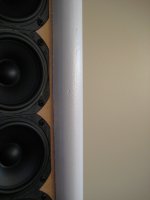 Array Side.jpg228 KB · Views: 5,373
Array Side.jpg228 KB · Views: 5,373 -
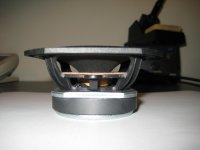 Driver - Side.JPG73.3 KB · Views: 5,171
Driver - Side.JPG73.3 KB · Views: 5,171 -
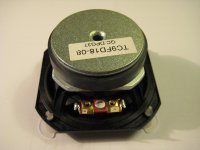 Driver - Rear.JPG105.1 KB · Views: 4,861
Driver - Rear.JPG105.1 KB · Views: 4,861 -
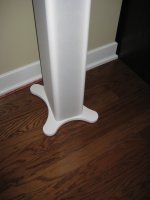 Finished - Painted base and white sock.JPG268.8 KB · Views: 4,882
Finished - Painted base and white sock.JPG268.8 KB · Views: 4,882 -
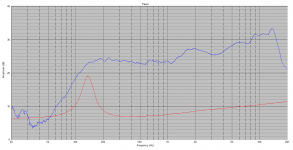 Frequency Response of a single raw driver.png63.3 KB · Views: 4,766
Frequency Response of a single raw driver.png63.3 KB · Views: 4,766 -
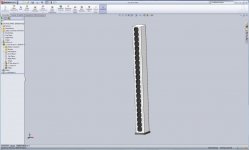 Screenshot - Line Array.jpg73.5 KB · Views: 1,818
Screenshot - Line Array.jpg73.5 KB · Views: 1,818 -
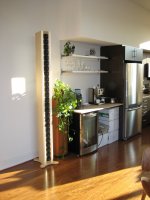 Unfinished.JPG479.7 KB · Views: 2,632
Unfinished.JPG479.7 KB · Views: 2,632 -
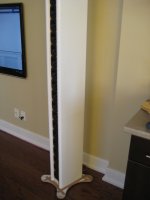 Unpainted base and no sock.JPG214.5 KB · Views: 2,476
Unpainted base and no sock.JPG214.5 KB · Views: 2,476 -
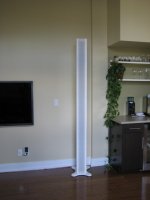 Finished Line Array.JPG209.5 KB · Views: 2,374
Finished Line Array.JPG209.5 KB · Views: 2,374
Last edited:
Thank you for the report, Owen
After I read about arrays, I decided to run a 2-way crossed at around 4,200 Hz to limit beaming. The tweeter line should also limit excessive EQ requirements which is important when used with guitar amps etc.
Very interested in your comments of the 1 to 2 meter sound change. I noted that when I was 1.5 to 2 meters back, testing my 5" woofers "full range" sounded much improved. Can't wait until I can hear the tweeter line come to life as I'm still waiting for XO parts to arrive.
You stated you tested eight different brands of 3" woofers and FRs--any of them Dayton ND-91s or Tangbands? My only concern is up to 4KHz with efficiency and bass response critical factors. My minimum efficiency is 85dB 1w/1m since I'll be using it with lower power amplifiers (guitar, car amps etc) and need final efficiency at least 96dB at one watt/one meter. The dream 3.5" would run 89dB with decent Xmax and Fs of 65Hz but I'm not holding my breath.
Fully agree with you on the amount of TIME it takes to build such things. Since I didn't know if I was building scrambled hash in an echo box, I made allowances to make it easily to upgrade the woofer line. Pull the machine screws, removed the bezel and cut out the 5" woofer holes portion and glue in a new bezel cut for 3 to 3.5" speakers. (The tweeter lines stay!) The Dayton ND-91 looks to be purpose built for arrays, I just wish it had more sensitivity.
Thanks again for the report, it helps pass the time and make me feel better while waiting for parts. Temp is 110F (43C) so the speakers get extra time to cook in the garage.
After I read about arrays, I decided to run a 2-way crossed at around 4,200 Hz to limit beaming. The tweeter line should also limit excessive EQ requirements which is important when used with guitar amps etc.
Very interested in your comments of the 1 to 2 meter sound change. I noted that when I was 1.5 to 2 meters back, testing my 5" woofers "full range" sounded much improved. Can't wait until I can hear the tweeter line come to life as I'm still waiting for XO parts to arrive.
You stated you tested eight different brands of 3" woofers and FRs--any of them Dayton ND-91s or Tangbands? My only concern is up to 4KHz with efficiency and bass response critical factors. My minimum efficiency is 85dB 1w/1m since I'll be using it with lower power amplifiers (guitar, car amps etc) and need final efficiency at least 96dB at one watt/one meter. The dream 3.5" would run 89dB with decent Xmax and Fs of 65Hz but I'm not holding my breath.
Fully agree with you on the amount of TIME it takes to build such things. Since I didn't know if I was building scrambled hash in an echo box, I made allowances to make it easily to upgrade the woofer line. Pull the machine screws, removed the bezel and cut out the 5" woofer holes portion and glue in a new bezel cut for 3 to 3.5" speakers. (The tweeter lines stay!) The Dayton ND-91 looks to be purpose built for arrays, I just wish it had more sensitivity.
Thanks again for the report, it helps pass the time and make me feel better while waiting for parts. Temp is 110F (43C) so the speakers get extra time to cook in the garage.
Hi Guys,
I just thought I would chime in here since I've built and have been living with a full range line array for the past year and a half.
I'm running the lines full range (without a sub) in a very large room, and I get genuinely flat response (-3dB) down to 20Hz. It's the absolute best bottom end you will ever hear from a loudspeaker.
Of course, there's the elephant in the room which I'm sure half of you were repeating constantly in your heads as you read this: comb filtering.
Honestly, it's not that big of deal. As speaker dave mentioned a while back, if you're playing pink noise, and standing within a meter or so of the loudspeakers, you can definitely hear the lobing effect by moving your head up and down. It's also very easy to measure with a measurement mic. Once you're out around the 2 meter mark, it's barely noticeable, and any farther than that, you simply can't hear it anymore.
Finally, I'd like to address the single biggest problem I have with the way people build these things:
DON'T USE CRUMMY DRIVERS!!!!!
This is a HUGE mistake, and I can promise you that if you start with junk, you'll end up with junk (just more of it). All 50 of my drivers cost me $333 which is actually cheap compared to most loudspeaker projects. The Vifa drivers I chose were a little bright straight out of the box, but with some EQ they were by far the best sounding of the group.
The amount of work involved in actually building a pair is enormous, which is why you really need to put the effort and money into using a good driver to start with. Putting that much work into something only to ruin it by using 50 cent drivers is a genuine shame.
I've attached a few pictures of the finished arrays, and hopefully someday I'll get around to properly documenting these in a proper project thread.
Cheers,
Owen
opc, very nice looking speakers. Do you have unequalized frequency response of an array, from far distance (1meter maybe) I'd be interested to see it.
Is there a reason (besides cost) why you didn't build them up to the ceiling height?
I agree with you about choosing good drivers, but sometimes sound quality is not the first priority.
Is there a reason (besides cost) why you didn't build them up to the ceiling height?
I agree with you about choosing good drivers, but sometimes sound quality is not the first priority.
- Home
- Loudspeakers
- Multi-Way
- Stupid Cheap Line Array